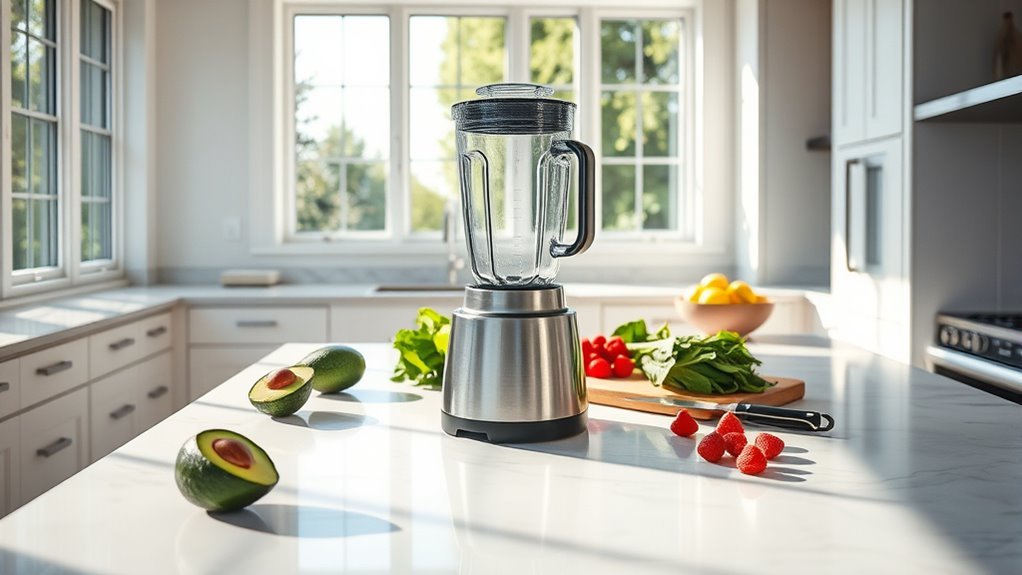We’ll cut through the marketing hype: blender peak horsepower ratings are misleading. A blender claiming 3 HP typically delivers only 2 HP during actual use. Focus on wattage instead – it’s the true measure of blending power. For smoothies, 300-500 watts works fine. Need to crush ice? Look for 1,000+ watts. Want nut butter? Target 1,500 watts. The real power lies in understanding the numbers behind the claims.
Peak Power Vs Operating Power: What Really Matters

While blender manufacturers love touting impressive peak horsepower numbers, we’ve got to get real about what actually matters.
That flashy peak power rating? It’s just the initial burst when the motor starts – not what you’ll get during actual blending.
Let’s look at the facts: The Vitamix 7500 claims 2.2 peak horsepower but actually operates at 1.93.
Blendtec blenders pull the same trick – their Classic 560 advertises 3 peak horsepower but delivers 2.41 during use.
We’re talking about significant drops in power output.
Here’s what you need to know: Focus on wattage instead of peak horsepower ratings.
It’s the operating power that determines real-world performance.
Those sky-high peak numbers might sound impressive, but they won’t make your smoothie any smoother. Also, high-performance blenders can handle tougher ingredients more effectively, leading to smoother textures in your blends.
Understanding Motor Specifications and Ratings
Since manufacturers often play fast and loose with motor specifications, let’s cut through the marketing hype and decode what these numbers actually mean.
When evaluating electric motors, we’re better off focusing on input power (watts) rather than peak power claims. Here’s why: While a blender might boast 3 horsepower ratings, its actual operating power could be just 1,560 watts – that’s 2.09 real horsepower.
The key lies in understanding that input power isn’t the same as output power. Most universal motors operate at 30-75% efficiency, meaning a significant portion of electrical energy is lost as heat. That’s why we recommend looking beyond flashy peak power numbers and focusing on motor specifications that directly impact performance – namely, sustained wattage and build quality. Additionally, high-performance blenders typically feature motor power ranges that exceed 1,000 watts, ensuring they can handle tougher ingredients efficiently.
Converting Watts to Horsepower: The Real Numbers

Before you trust those impressive horsepower claims, let’s do some real math.
Converting watts to horsepower is straightforward: one horsepower motor equals 746 watts. The blender market loves touting maximum power numbers, but rated watts tell the real story.
- A 1,440-watt blender delivers 1.93 horsepower during actual use – far less than many inflated marketing claims.
- When shopping, divide the rated watts by 746 to get true horsepower (e.g., 1,560 watts = 2.09 hp).
- Motors power peaks at startup then drops considerably during operation – that’s why manufacturers’ peak horsepower claims often mislead.
Bottom line: Focus on rated watts, not advertised horsepower. A 1,500-watt blender will consistently outperform lower-wattage models, regardless of flashy horsepower numbers on the box.
Common Marketing Claims and Their Accuracy
As blender manufacturers compete for your attention, they’re resorting to increasingly creative marketing tactics that don’t tell the whole story. Let’s expose the gap between marketing claims and reality.
| Model | Peak HP (Marketed) | Actual HP |
|---|---|---|
| Vitamix 7500 | 2.2 | 1.93 |
| Blendtec 560 | 3.0 | 2.41 |
| Ninja Mega | Lower | Similar |
We’ve found that peak horsepower ratings create significant consumer confusion. These numbers reflect brief power spikes during startup—not sustainable blending power. Take the Vitamix 7500: it’s advertised at 2.2 peak horsepower but actually operates at 1.93 HP during use. Want the truth? Focus on actual wattage, calculated from input amperage and voltage. It’s the only reliable measure of real-world performance.
Testing Methods for Actual Motor Performance

Marketing claims won’t tell you the real story – but rigorous testing will. To measure the actual performance of a blender motor, we need precise methods that reveal true input power and efficiency calculations.
Let’s cut through the fluff and examine how we verify electrical power ratings.
- We measure input power using specialized meters like Kill-A-Watt, capturing real consumption between 300-1,500 watts during operation.
- Using UL 982’s standardized test load (diced carrots and water in 2:3 ratio), we determine consistent power output across different models.
- Through water brake testing, we track temperature changes (0.17°F/sec = 1.1 horsepower) to verify actual motor performance.
These methods expose the truth about motor efficiency, which typically ranges from 30-75% – far from the inflated numbers you’ll see on packaging.
Impact of Motor Power on Blending Results
While motor power ratings often get tossed around like confetti, let’s nail down what they really mean for your blending results.
We’ve found that actual operational wattage – not fancy peak horsepower claims – determines your blender’s true capabilities. A minimum of 350 watts is needed to crush ice effectively, but high-performance blenders like the Vitamix 7500 deliver 1,440 watts for superior results.
Here’s what matters: variable speed control paired with sufficient motor power guarantees smooth blends across different ingredients.
When manufacturers boast about peak horsepower (looking at you, Blendtec), remember it’s the sustained power that counts. Sure, high-performance blenders cost more, but their stronger motors handle demanding tasks better and last longer.
Think of it as investing in consistently superior blending results.
Selecting the Right Power Level for Your Needs
Let’s cut through the wattage confusion and pinpoint exactly what power you need. When shopping for blenders, rated wattage trumps flashy peak horsepower claims every time. We’ve found that matching power to purpose saves both money and counter space.
- For basic fruit smoothies and soft blending, grab a 300-500 watt model with good warranty coverage – it’ll handle daily breakfast duties without breaking the bank.
- Need crushed ice and frozen ingredients? Don’t go below 1,000 watts unless you enjoy the sound of struggling motors.
- For heavy-duty tasks like nut butters, invest in 1,000-1,500 watts with maximum speed control – your blender’s mechanical efficiency should exceed 60% for peak performance.
Remember: variable speeds matter as much as raw power. The right combination gives you precision control from gentle mixing to industrial-strength pulverizing.
Frequently Asked Questions
Is 1500 Watts a Lot for a Blender?
We’d consider 1500 watts quite powerful for a blender, offering excellent power efficiency and recipe compatibility. User reviews confirm strong blender performance, though higher motor durability may mean increased noise levels.
What Does Peak Watts Mean on a Blender?
Peak watts show a blender’s maximum power at startup, but we’d encourage you to focus on continuous wattage ratings instead, as they better reflect the actual blending power you’ll experience daily.
Is 700 Watts Good for a Blender?
We’d consider 700 watts adequate for basic blending tasks, though motor efficiency varies by brand. It’ll handle smoothies and soups fine, but might struggle with tougher blending challenges.
How Can You Tell How Powerful a Blender Is?
We can judge a blender’s power by checking wattage, measuring blending speed and smoothie consistency, listening to noise levels, and monitoring energy consumption through actual use testing.

